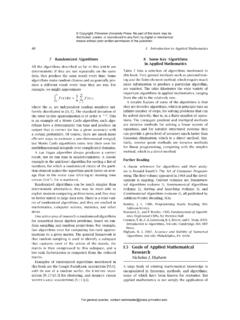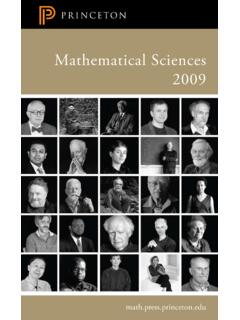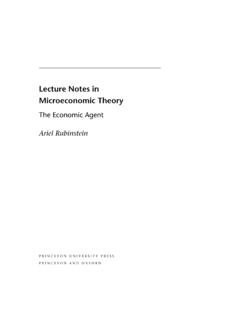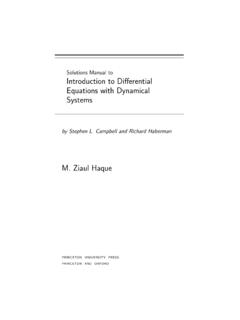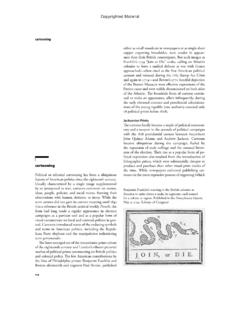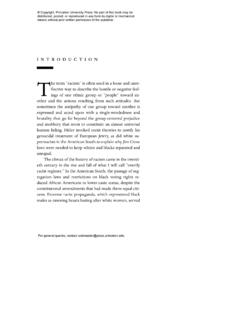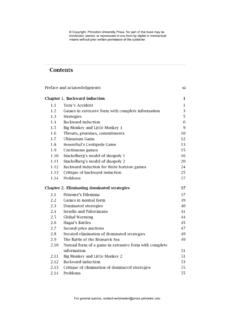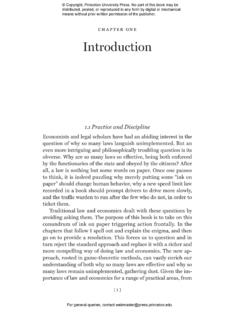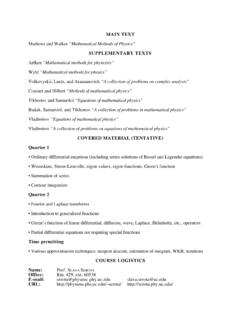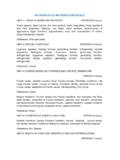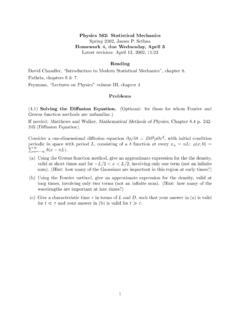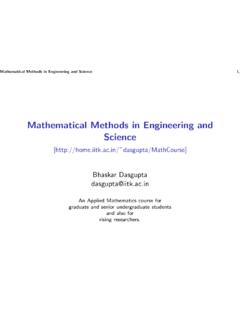Transcription of Mathematical Methods for Geophysics and Space …
1 Newman 2016/2/8 17:00 page1 #17 CHAPTER ONEM athematical PreliminariesThe underlying theory for Geophysics , planetary physics , andspace physics requires a solid understanding of many of themethods of Mathematical physics as well as a set of special-ized topics that are integral to the diverse array of real-worldproblems that we seek to understand. This chapter will reviewsome essential Mathematical concepts and notations that arecommonly employed and will be exploited throughout this will begin with a review of vector analysis focusing on indi-cial notation, including the Kronecker and Levi-Civita per-mutation symbol, and vector operators. Cylindrical and spheri-cal geometry are ubiquitous in Geophysics and Space physics , asare the theorems of Gauss, Green, and Stokes. Accordingly, wewill derive some of the essential vector analysis results in Carte-sian geometry in these curvilinear coordinate systems.
2 We willproceed to explore how vectors transform in Space and the roleof rotation and matrix representations, and then go on to intro-duce tensors, eigenvalues, and eigenvectors. The solution of the(linear) partial differential equations of Mathematical physics iscommonly used in Geophysics , and we will present some materi-als here that we will exploit later in the development of Green sfunctions. In particular, we will close this chapter by introduc-ing the ramp, Heaviside, and Dirac functions. As in all of ourremaining chapters, we will provide a set of problems and citereferences that present more detailed investigations of Vectors, Indicial Notation, and Vector OperatorsThis book primarily will pursue the kinds of geophysical prob-lems that emerge from scalar and vector quantities. While men-tion will be made of tensor operations, our primary focus will beupon vector problems in three dimensions that form the basisof Geophysics .
3 Scalars and vectors may be regarded as tensors Newman 2016/2/8 17:00 page2 #18 21. Mathematical Preliminariesof a specific , such as density and tem-peratures, such as velocities have an associated direction as well as amagnitude. Vectors arefirst-ranktensors and are usually des-ignated by boldface lower-case tensors,orsimplytensors, such as the stress tensor are a special case ofsquare matrices. Matrices are generally denoted by boldface,uppercase letters, while tensors are generally denoted by bold-face, uppercase, sans-serif letters (Goldstein et al., 2002). Forexample,Mwould designate a matrix whileTwould designatea tensor. [There are other notations, , Kusse and Westwig(2006), that employ overbars for vectors and double overbars fortensors.] Substantial simplification of notational issues emergesupon lieu ofx,y, andzin describing the Cartesian componentsfor position, we will employx1,x2, andx3.
4 Similarly, we willdenote by e1, e2, and e3the mutually orthogonalunit vectorsthatare in the direction of thex1,x2, andx3axes. (Historically, theuse ofeemerged in Germany where the letter e stood for thewordEinheit, which translates as unit. ) The indicial notationimplies that any repeated index is summed, generally from 1through 3. This is theEinstein summation is sufficient to denote a vectorv, such as the velocity, by itsthree components(v1,v2,v3). We note thatvcan be representedvectorially by its component terms, namely,v=3 i=1vi ei=vi ei.( )SupposeTis a tensor with componentsTij. Then,T=3 i=1,j=1 Tij ei ej=Tij ei ej.( )We now introduce theinner product, also known as a scalar prod-uct or dot product, according to the conventionu v uivi.( )Moreover, we defineuandvto be the lengths ofuandv, respec-tively, according tou uiui=|u|;v vivi=|v|;( ) Newman 2016/2/8 17:00 page3 #19 Vectors, Indicial Notation, and Vector Operators3we can identify an angle betweenuandvthat we defineaccording tou v uvcos ,( )which corresponds directly to our geometric now introduce the Kronecker according to ij= 1ifi=j,0ifi =j.
5 ( )The Kronecker is the indicial realization of the identity follows, then, that ei ej= ij,( )and that ii=3.( )This is equivalent to saying that thetrace, that is, the sum ofthe diagonal elements, of the identity matrix is 3. An importantconsequence of Eq. ( ) is that ij ej= ei.( )A special example of these results is that we can now derive thegeneral scalar product relation ( ), namely,u v=ui ei vj ej=uivj ei ej=uivj ij=uivi,( )by applying Eq. ( ).We introduce the Levi-Civita or permutation symbol ijkinorder to address thevector productorcross product. In partic-ular, we define it according to ijk= 1ifijkare an even permutation of 1 2 3, 1ifijkare an odd permutation of 1 2 3,0if any two ofi,j,kare the same.( )We note that ijkchanges sign if any two of its indices are inter-changed. For example, if the 1 and 3 are interchanged, then , we define the crossproductu vaccording to itsith component, namely,(u v)i ijkujvk,( )or, equivalently,u v=(u v)i ei= ijk eiujvk= (v u).
6 ( ) Newman 2016/2/8 17:00 page4 #20 41. Mathematical PreliminariesIt is observed that this structure is closely connected to the defi-nition of the determinant of a 3 3 matrix, which emerges fromexpressing the scalar triple productu (v w)= ijkuivjwk,( )and, by virtue of the cyclic permutivity of the Levi-Civita symbol,demonstrates thatu (v w)=v (w u)=w (u v).( )The right-hand side of Eq. ( ) is the determinant of a matrixwhose rows correspond tou,v, notation facilitates the calculation of quantities suchas the vector triple cross productu (v w)=u ijk eivjwk= lmi elum ijkvjwk=( ilm ijk) elumvjwk.( )It is necessary to deal first with the ilm ijkterm. Observe, aswe sum over theiindex, that contributions can emerge only ifl =mandj =k. If these conditions both hold, then we get acontribution of 1 ifl=jandm=k, and a contribution of 1ifl=kandm=j. Hence, it follows that ilm ijk= j mk lk mj.
7 ( )Returning to ( ), we obtainu (v w)=( lj mk lk mj) elumvjwk= elvlumwm elwlumvm=v(u w) w(u v),( )thereby reproducing a familiar, albeit otherwise cumbersome toderive, algebraic identity. Finally, if we replace the role ofuinthe triple scalar product ( ) byv w, it immediately followsthat(v w) (v w)=|v w|2= ijkvjwk ilmvlwm=( jl km jm kl)vjwkvlwm=v2w2 (v w)2=v2w2sin2 ,( )where we have made use of the definition for the angle givenin ( ). Newman 2016/2/8 17:00 page5 #21 Vectors, Indicial Notation, and Vector Operators5 The Kronecker and Levi-Civita permutation symbols sim-plify the calculation of many other vector identities, includingthose with respect toderivativeoperators. We define iaccord-ing to i xi,( )and employ it to define the gradient operator , which is itselfa vector: = i ei.( )Another notational shortcut is to employ a subscript of ,i todenote a derivative with respect toxi; importantly, a comma , is employed together with the subscript to designate differenti-ation.
8 Hence, iffis a scalar function ofx, we write f xi= if=f,i;( )but ifgis a vector function ofx, then we write gi xj= jgi=gi,j.( )Higher derivatives may be expressed using this shorthand aswell, for example, 2gi xj xk=gi,jk.( )Then, the usual divergence and curl operators become u= iui=ui,i( )and u= ijk ei juk= ijk eiuk,j.( )Our derivations will employ Cartesian coordinates, primarily,since curvilinear coordinates, such as cylindrical and sphericalcoordinates, introduce a complication insofar as the unit vec-tors defining the associated directions change. However, once wehave obtained the fundamental equations, curvilinear coordin-ates can be especially helpful in solving problems since they helpcapture the essential geometry of the Earth. Newman 2016/2/8 17:00 page6 #22 61. Mathematical Cylindrical and Spherical GeometryTwo other coordinate systems are widely employed in geo- physics , namely, cylindrical coordinates and spherical coordin-ates.
9 As we indicated earlier, our starting point will always be thefundamental equations that we derived using Cartesian coordin-ates and then we will convert to coordinates that are more nat-ural for solving the problem at hand. Let us begin in two dimen-sions with polar coordinates(r, )and review some fundamen-tal usual, we relate our polar and Cartesian coordinates ac-cording tox=rcos y=rsin ,( )which can be inverted according tor= x2+y2 =arctan(y/x).( )Unit vectors in the new coordinates can be expressed r=cos x+sin y = sin x+cos y.( )We recall how to obtain the various differential operations, suchas the gradient, divergence, and curl, by using the chain rule ofmultivariable calculus. Suppose thatfis a scalar function ofxandy, and we wish to transform its Cartesian derivatives intoderivatives with respect to polar coordinates. From the chainrule, it follows that f x= r x y f r + x y f r=cos f r sin r f ,( )where the vertical bar followed by a subscript designates thevariable or variables that are held fixed.
10 In like fashion, we canderive f y=sin f r+cos r f .( )Finally, we can obtain theLaplacianof a scalar quantity in twodimensions, 2, defined according to 2f f= 2f x2+ 2f y2=1r r r f r +1r2 2f 2.( ) Newman 2016/2/8 17:00 page7 #23 Cylindrical and Spherical Geometry7 Integrals in two dimensions require the transformation of dif-ferential area elements from dxdytord dr. Therefore, theintegral offover some areaAcan be expressed equivalently as Af(x,y)dxdy= Af(x1,x2)dx1dx2= Af(x)dA= Af(x)d2x= Af(r, )rdrd ,( )where the areas of integration are kept the same and integrationover two variables is now move on to review three-dimensional geometry where-in polar coordinates become either cylindrical or spherical polarcoordinates. We begin with cylindrical coordinates, which nowintroduce the third orzdimension. Accordingly, we observe thatthe Laplacian becomes 2f=1r r r f r +1r2 2f 2+ 2f z2,( )where we assume thatris measured in thex-yplane, thatis, it is not the radial distance from the origin to the point inquestion.
